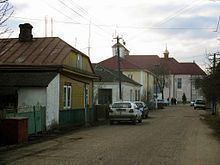Country Belarus Founded 11th century Time zone EET (UTC+2) Voblast Minsk Region | Raion Kletsk Raion Population 11,237 Local time Thursday 7:48 AM | |
 | ||
Weather 2°C, Wind W at 14 km/h, 93% Humidity | ||
Kletsk (Belarusian: Клецк, originally known as Klechesk, Russian: Клецк, Polish: Kleck) is a city in the Minsk Region of Belarus, located on the Lan River. In 2015 it had 11,237 inhabitants.
Contents
Map of Kletsk, Belarus
History
The town was founded in the 11th century by the Dregovichs, who erected a large fort and a tribal centre there. In the 14th century the town became part of the Grand Duchy of Lithuania and then part of the Polish-Lithuanian Commonwealth in the wake of the Polish-Lithuanian Unions. In the 1506 Battle of Kleck, the Polish-Lithuanian forces under Michał Gliński defeated the Tartar armies and saved the town from being pillaged. Soon afterwards, the town became a property of the Radziwiłł magnate family, who started to attract Jewish settlers to the area.
The earliest known mention of the local Jewish community is a document dated September 5, 1522, issued by King Sigismund I the Old of Poland. In it, the monarch awarded for three years to Isaac Jesofovitch, a Jew of Brest, for the sum of 300 times sixty grosz a lease of the inns and other sources of revenue in Kletsk. The next mention of the Kletzk community, as it was known in Yiddish, is found in a document dated January 21, 1529, which imposes military duties on its inhabitants, as well as on those of other towns. On June 15, 1542, the boyar Grishko Kochevich brought suit against Zachariah Markovich, a Jew of Kletzk, the latter's oxen having broken into Grishko's field and injured the growing grain; the court awarded to Grishko twelve "ruble groschen" damages.
A census taken in 1552-55 shows that the Jewish householders lived chiefly on Wilna street, on the Sloboda, and owned gardens in the suburbs. Kletzk is mentioned in the assessment on the Lithuanian communities in 1566, and from its small proportionate assessment it appears that the community was not important at that time.
In 1586 the town became the capital of Radziwiłł's ordynacja, which sparked the gradual development of the town into a regional centre of commerce. By the end of the following century the number of Jews grew significantly; the town was also one of the notable centre of Calvinism, sponsored by the Radziwiłł family.
The first rabbi of Kletzk was Judah ben Löb, who also had under his jurisdiction the community of Mechit. He was succeeded by Michael ben Meïr Eisenstadt, who in turn was followed, about 1762, by his son Moses Eisenstadt (d. Oct. 25, 1795). According to a local legend, the philosopher Salomon Maimon had lived there for several years, and was intimate with Moses Eisenstadt.
Until 1623 the town was a part of the powiat of Brześć; after that date it was transferred, together with the neighbouring towns, to the district of Pinsk. According to tradition, the town originally was located on the opposite bank of the river, on the road leading to Lyakhovich; but after the destructive fire of 1705 it was rebuilt, at the instance of the Voivode, on its present site.
Annexed by the Russian Empire after the Second Partition of Poland in 1793, the town was repeatedly destroyed by fire in the 19th century, including in 1817, 1845, 1865, and 1886. In 1903 Kletzk had a total population of about 8,000, of which about 6,000 were Jews. After the Polish-Bolshevik War the town was restored to Poland as parish (gmina) centre in Nieśwież county (powiat) of Nowogródek Voivodeship, only to be annexed by the Soviet Union in 1939 and then by Nazi Germany in 1941.
During the German occupation a large massacre of local Jews took place in the town on October 6, 1941, with circa 4,000 people murdered. The remaining Jews of the area (approximately 2,000 people) were massed in a local ghetto and then sent to various German concentration camps by August 21, 1942. The Holocaust brought an end to a vibrant Jewish life. Among the monuments of the Jewish past destroyed during World War II were a Jewish cemetery, a large synagogue founded by Prince Radziwiłł in 1796; a bet ha-midrash built in the early 18th century and fifteen smaller houses of prayer.
After the war the town was a part of the Belorussian SSR. Since 1991, it has been a part of Belarus.
Architecture
Before the last war, the town's oldest building was the mid-16th-century Trinity cathedral. It was seriously damaged during World War II and eventually blown up by the Soviets in the 1950s. Its ruins are still visible, however. Currently, the town's main architectural landmark is the Church of the Resurrection, which was built in the provincial Baroque style in 1683.
